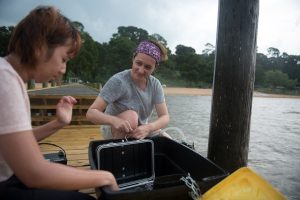
From the UA News Center | A novel international review of available investigations found groundwater’s influence on oceans is a critical component of coastal ecosystems’ health.
Published today in Nature Reviews Earth and Environment, the study involves data from Mobile Bay collected by researchers at The University of Alabama. It’s the first paper to summarize groundwater’s contributions to the nutrients delivered to coastal waters on a global scale, said Dr. Natasha Dimova, an associate professor of geological sciences and co-author on the paper.
Using peer-reviewed data collected at more than 200 sites in coastal areas around the world, the study revealed groundwater, which is water that seeps underground and flows from land into the ocean through the seabed, contributed more nutrients than rivers in 60 percent of the sites and was an important contributor in many others.
Excessive nutrients, particularly nitrogen from crop fertilizers, drive widespread areas of low oxygen in coastal waters that threaten marine life, but nutrient contributions from groundwater are often overlooked in water quality models and in policies that almost exclusively consider surface water, the main contributor of nutrients to the seas.
“This is the first work that demonstrates that nutrient contributions from groundwater discharge is a factor on a global scale, and not a local issue in ‘our backyard,’” Dimova said. “It also prompts us to investigate the changes different containments undergo before discharging to the coastal zone. We must know this to take proper measures on coastal water quality. Local fishery communities depend directly on such information.”
Although groundwater contributes less than 3% of water to Mobile Bay, it plays an outsized influence on its water quality, according to previously published research from Dimova’s research group. In the dry season, groundwater brings half of the nitrogen derived as ammonium into the bay, according to studies by Dimova.
Nitrogen is critical for the health of coastal waters, but too much of it brings problems that can affect water quality and economic activity, such as the lively seafood industry. It can lead to harmful algae blooms that result in jubilees, moments when huge numbers of marine life such as fish and crabs swarm shallow waters that can cause a massive fish kill.
The global review found that, along with fresh water from underground aquifers, there is also groundwater that is essentially recycled sea water mixed with fresh water that seeps in and out of the ground with the tides, releasing nutrients stored from decaying organic material, sometimes stored for hundreds of years.
Dimova found a similar phenomenon in Mobile Bay where the coastal sediment can capture nutrients from fresh groundwater, leaving the mix of fresh and saltwater right along the coast to release a changed groundwater that lacks oxygen.
“We suggest that this discharge on the seafloor, along with other environmental factors developing in the bay, is a factor in the development of ‘bottom-up’ hypoxia and the jubilees along the Alabama-Mississippi coastline,” she said.
The field of coastal groundwater research took off in the 1990s when methods for detecting groundwater seepage using naturally occurring radioisotopes of radon and radium were developed, allowing for much easier and automatic data collection. Dimova’s former lab at Florida State University, where she earned her doctorate, is one of two labs that pioneered this method development.
Along with data from Mobile Bay, Dimova and her students contributed data from other locations including Southern Spain and Alaska.
The effort was led by Dr. Isaac Santos, professor of marine chemistry at the University of Gothenburg in Sweden, the corresponding author on the paper that involved contributions from researchers at 13 universities.
Aspects of Dimova’s research for this paper were funded by the National Science Foundation.